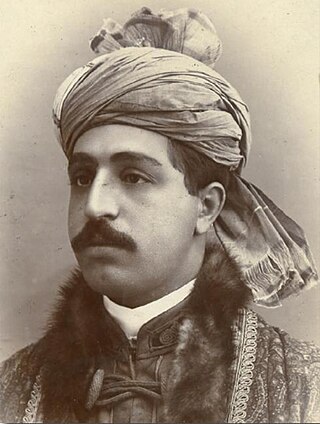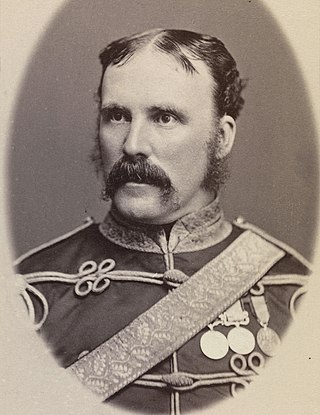
Abdur Rahman Khan also known by his epithets, The Iron Amir, or The Dracula Amir, was Amir of Afghanistan from 1880 to his death in 1901. He is known for uniting the country after years of internal fighting and negotiation of the Durand Line Agreement with British India.

European influence in Afghanistan has been present in the country since the Victorian era, when the competing imperial powers of Britain and Russia contested for control over Afghanistan as part of the Great Game.

The Second Anglo-Afghan War was a military conflict fought between the British Raj and the Emirate of Afghanistan from 1878 to 1880, when the latter was ruled by Sher Ali Khan of the Barakzai dynasty, the son of former Emir Dost Mohammad Khan. The war was part of the Great Game between the British and Russian empires.

The Treaty of Gandamak officially ended the first phase of the Second Anglo-Afghan War. Mohammad Yaqub Khan ceded various frontier areas as well as Afghanistan's control of its foreign affairs to Britain.

The Battle of Maiwand, fought on 27 July 1880, was one of the principal battles of the Second Anglo-Afghan War. Under the leadership of Ayub Khan, the Afghan forces defeated a much smaller British force consisting of two brigades of British and Indian troops under Brigadier-General George Burrows, albeit at a high price: between 2,050 and 2,750 Afghan warriors were killed, and probably about 1,500 wounded. British and Indian forces suffered 1,200 dead.

Mohammad Yaqub Khan was Emir of Afghanistan from February 21 to October 12, 1879. He was a Pashtun and the son of the previous ruler, Sher Ali Khan.

Ghazi Mohammad Ayub Khan also known as The Victor of Maiwand or The Afghan Prince Charlie was, for a while, the governor of Herat Province in the Emirate of Afghanistan. He was Emir of Afghanistan from 12 October, 1879 to 31 May, 1880. He also led the Afghan troops during the Second Anglo-Afghan War and defeated the British Indian Army at the Battle of Maiwand. Following his defeat at the Battle of Kandahar, Ayub Khan was deposed and exiled to British India. However, Ayub Khan fled to Persia. After negotiations in 1888 with Sir Mortimer Durand, the ambassador at Tehran, Ayub Khan became a pensioner of the British Raj and traveled to British India in 1888, where he lived until his death in 1914 in Lahore, Punjab. He was buried in Peshawar and had eleven wives, fifteen sons, and ten daughters. Two of his grandsons, Sardar Hissam Mahmud el-Effendi and Sardar Muhammad Ismail Khan, served as brigadiers in the Pakistan Army.

The Battle of Ahmed Khel took place during the Second Anglo-Afghan War. It was fought on 19 April 1880, on the road between Kandahar and Kabul in central Afghanistan between Afghan tribesmen and soldiers of the British Empire, including forces from both British and Indian armies.

Maiwand is a village in Afghanistan within the Maywand District of Kandahar Province. It is located 50 miles northwest of Kandahar, on the main Kandahar–Lashkargah road.

The siege of the Sherpur Cantonment was a battle fought in December 1879, during the Second Anglo-Afghan War.
The Second Battle of Charasiab was fought on 25 April 1880 between the British Empire and Afghan tribesmen, during the Second Anglo-Afghan War.

Vereker Monteith Hamilton was a Scottish artist of military and historical works.
Malalai of Maiwand, also known as Malala, or Malalai Anna is a national folk hero of Afghanistan who rallied Pashtun fighters during the Battle of Maiwand. She fought alongside Ayub Khan and was responsible for the Afghan victory at the Battle of Maiwand on 27 July 1880, during the Second Anglo-Afghan War. She is also known as "The Afghan Jeanne d'Arc" or as "The Afghan Molly Pitcher" to the Western world. There are many schools, hospitals, and other institutions named after her in Afghanistan. Her story is told in Afghan school text books.

The Kabul Field Force was a field force created in September 1879 during the Second Anglo-Afghan War, under the command of General Frederick Roberts. It combined British Army and British Indian Army regiments, and initially numbered around 7,500 men, but later reached about 14,000.

The Kabul to Kandahar Star, also known as the Roberts Star or Kandahar Bronze Star was awarded to those British and Indian troops who participated in the 320 mile march from Kabul to Kandahar in Afghanistan between 9–31 August 1880, under the command of Lieutenant-General Sir Frederick Roberts who rode horseback on his horse Vonolel In addition, it was awarded to the troops stationed en route at Kelat-i-Ghilzie, who accompanied General Roberts on the final ninety miles to Kandahar.

The siege of the British Residency in Kabul was a military engagement of the Second Anglo-Afghan War. The British resident, Sir Louis Cavagnari and his escort were massacred after an 8-hour siege by mutinous Afghan troops inside their Residency in Kabul. This event triggered the second phase of the war, during which an Anglo-Indian army invaded Afghanistan and captured Kabul.
Nazir Muhammad Sarwar Khan was the Governor of Herat from August 1882 to November 1886. A loyal supporter of Abdur Rahman, he accompanied the future Amir into exile and was rewarded with high office upon their return to Afghanistan. However, he was stripped of his role after accusations of corruption, and died in prison.

Major George Frederick Blackwood (1838–1880) of the Royal Horse Artillery was a Scottish artillery officer in the service of the East India Company and the Raj. He was killed in action at the Battle of Maiwand, a major British defeat.

Brigadier-General Henry Francis Brooke (1838–1880), commanding the 2nd Infantry Brigade, Kandahar Field Force, was an Irish officer in the British Army. He was killed in a sortie from Kandahar on 16 August 1880, while endeavouring to save the life of a fellow officer.





















